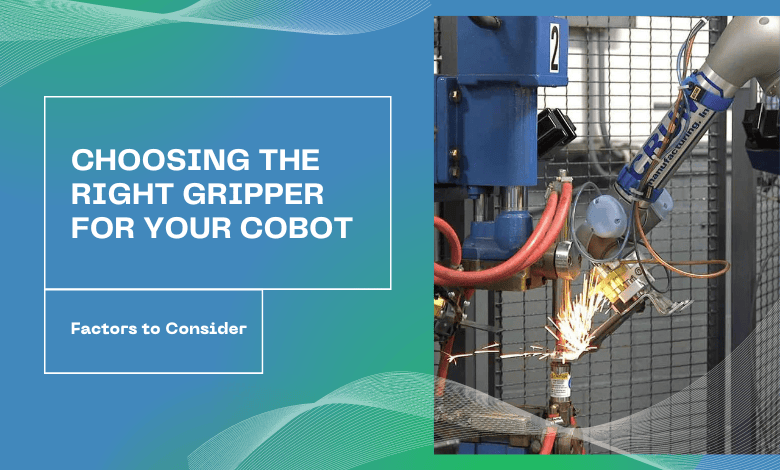Choosing the Right Gripper for Your Cobot: Factors to Consider

In today’s rapidly evolving industrial landscape, collaborative robots, or cobots, are revolutionizing the way tasks are performed in various industries. However, the effectiveness of cobots heavily relies on the gripper end effector they use to interact with objects. Selecting the right gripper for your cobot is crucial for optimizing its performance and ensuring seamless integration into your workflow. In this comprehensive guide, we’ll explore the key factors to consider when choosing a gripper for your cobot, providing valuable insights for informed decision-making.
Understanding Cobots and Grippers
Cobots are a type of robotic technology specifically designed to collaborate with human workers in shared workspaces. Unlike traditional industrial robots, cobots are lightweight, compact, and inherently safe, featuring advanced sensors and software that enable them to work alongside humans without the need for physical barriers.
Grippers are essential components of cobots, responsible for grasping, manipulating, and moving objects during various tasks. Grippers come in different types, including pneumatic, electric, hydraulic, and vacuum, each offering unique capabilities suited to other applications.
Factors to Consider When Choosing a Gripper
One of the primary considerations when selecting a gripper and effector for your cobot is the payload capacity it can handle. Assessing the weight of the objects your cobot will be handling is crucial to ensure that the gripper can effectively lift and manipulate them without compromising performance or safety.
The gripping force and speed of a gripper play a significant role in its ability to hold objects securely and perform tasks efficiently. Depending on the application requirements, you may need a gripper with adjustable gripping force and speed settings to accommodate different objects and functions. Consider the materials of the objects your cobot will be handling, as this will impact the type of gripper required. Grippers with specialized coatings or materials may be necessary to handle delicate or slippery objects effectively, ensuring a secure grip and precise manipulation.
Versatility is essential when choosing a gripper for your cobot, as it should be able to adapt to a wide range of tasks and object shapes. Look for grippers with modular designs or interchangeable fingers that allow for easy customization and adaptation to different applications. Ensure that the gripper you choose is compatible with your cobot model and specifications. Consider factors such as mounting options, communication protocols, and programming interfaces to ensure seamless integration and optimal performance.
Comparison of Gripper Technologies
Pneumatic Grippers
Pneumatic grippers are powered by compressed air and are known for their fast response times and high gripping forces. However, they may require additional equipment for air supply and can be less precise compared to other gripper types.
Electric Grippers
Electric grippers offer precise control over gripping force and position, making them ideal for applications requiring delicate handling or accurate positioning. However, they may have lower gripping forces compared to pneumatic grippers and may require additional power sources.
Hydraulic Grippers
Hydraulic grippers utilize hydraulic fluid to generate gripping force and are capable of handling heavy loads with ease. However, they can be more complex to integrate and maintain, requiring hydraulic systems and fluid management.
Vacuum Grippers
Vacuum grippers use suction to hold objects securely and are ideal for handling flat or non-porous objects such as glass or metal sheets. However, they may struggle with irregularly shaped or porous objects and may require additional equipment to create and maintain vacuum pressure.
Guidance on Gripper Integration and Testing
Follow manufacturer guidelines and best practices for installing and configuring your gripper for optimal performance and safety. Ensure proper alignment, calibration, and connection to your cobot system before operation. Conduct thorough testing and validation of gripper-cobot integration to verify compatibility, performance, and safety. Test various scenarios and tasks to identify any issues or limitations and make necessary adjustments accordingly.
Be prepared to troubleshoot common integration issues such as communication errors, alignment issues, or mechanical failures. Consult manufacturer documentation, support resources, or seek assistance from experienced professionals if needed.
Future Directions and Innovations in Gripper Technology
Continued research and development are driving advancements in gripper design, with a focus on enhancing performance, adaptability, and intelligence. Expect to see improvements in materials, actuation methods, and ergonomic designs. The integration of artificial intelligence (AI) and machine learning (ML) technologies is enabling grippers to learn and adapt to different objects, tasks, and environments autonomously. This adaptive gripping capability holds immense potential for increasing efficiency and flexibility in cobot applications.
The widespread adoption of 3D printing technology is revolutionizing the production of custom grippers, allowing for rapid prototyping and iteration of designs. This democratization of manufacturing enables companies to create bespoke grippers tailored to their specific application needs quickly and cost-effectively.
Conclusion
Selecting the right gripper for your cobot is a critical decision that requires careful consideration of various factors, including payload capacity, gripping force, material handling capabilities, and environmental conditions. By understanding your application requirements and evaluating the pros and cons of different gripper technologies, you can make an informed choice that maximizes the performance and efficiency of your cobot system.
As technology continues to evolve and new innovations emerge, the future of gripper technology holds exciting possibilities for advancing automation and collaboration in industrial settings.
Check out these invaluable insights and embark on your journey to success today!





